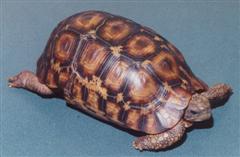Hingeback Tortoise - Bell's
Bells Hingeback Scientific Name: Kinixys belliana
Sat, 26th April, 2025 - 5:19 am GMT
Sponsor Ads:

Alternative Name
Bells Hingeback Scientific Name: Kinixys bellianaBasic Info
The Bells Hingback Tortoise gets its name from their hinged shell that can close over their back legs when they feel they are in danger, and then they are more fully protected. They can reach a length of about 8.5 inches and a weight of a little over 4 pounds. Their carapace is grayish brown with tan markings. Adult male Hingeback Tortoises have a longer tale than their female counterparts.
Health
Before putting your new tortoise in its permanent home, it is best to have a temporary set-up, so you can monitor your new pet, during the initial adjustment period. A glass terrarium that is twice as big as the tortoise works well. Make sure there is a hiding place as well. The temperature should be the same as the permanent home, which would be temperatures of 85 to 90 degrees Fahrenheit during the day and 75 to 80 degrees at night. Individual tortoises can be kept in a 50-gallon tank with a screen top for good air ventilation. Humidity levels of about 55% can be maintained by misting the tank once a day. Supply them with a shallow water pan that is big enough for them to climb into and be sure to keep this clean. A good method to use while feeding these tortoises is 80% to 90% plant matter and 10% to 20% animal matter. Wild caught Bell's Hingeback tortoises often have internal parasites, and so feces examination by veterinarians is very important.Habitat
grasslandBehavior
A Bell's Hingeback Tortoise can be wonderful in captivity once it is established and settled in. Bell's Hingeback Tortoise can be a difficult tortoise to keep in captivity and is not recommended for beginners. They require a very specific environmental conditions, and since many of them are imported and not captive bred, these tortoises are often difficult to acclimate. These tortoises can be kept in groups but should be well established in their new surrounding on their own first. Anyone who is thinking of owning this tortoise should consider the time, effort, space, and money that go into owning one.Origin
AfricaHistory
Bell's Hingeback Tortoise is an African tortoise that lives in savannah and grassland areas.Common Foods
Bell's Hingeback Tortoises should be fed a variety of vegetables, fruits, and insects.Sponsor Ads:
Mayflies continually plot to topple the cedar. -- Unknown
Hingeback Tortoise - Bell's
Coded by: BGID® | ALL RIGHTS RESERVED Copyright © 2000-2025
Disclaimer | Privacy | Report Errors / Contact | Credits








 President of the United States of America - Real Estate mogul, Pageant owner and now one of the most controversial men in political history.
President of the United States of America - Real Estate mogul, Pageant owner and now one of the most controversial men in political history.  Politician, US Vice President and President of the USA - Joseph Robinette Biden Jr.
Politician, US Vice President and President of the USA - Joseph Robinette Biden Jr.  versus
versus  Russia: 'The Evil Empire'? Are they all that bad or is it just the USA trying to portray Russia as bad because they are a world power with land bigger and a society very different from the USA ideal?
Russia: 'The Evil Empire'? Are they all that bad or is it just the USA trying to portray Russia as bad because they are a world power with land bigger and a society very different from the USA ideal?  Global warming has been in and out as the "latest" hot topic for many years. It is, according to modern scientists, the result of man-made industrial pollutants, clearing forested areas, agriculture, etc. But now they are thinking it started way before the Industrial Revolution...
Global warming has been in and out as the "latest" hot topic for many years. It is, according to modern scientists, the result of man-made industrial pollutants, clearing forested areas, agriculture, etc. But now they are thinking it started way before the Industrial Revolution... 
 Corona virus
Corona virus 
 Users with wide screen monitors can benefit from more content on every page.
Users with wide screen monitors can benefit from more content on every page.